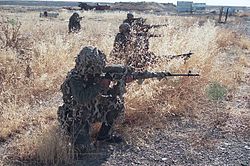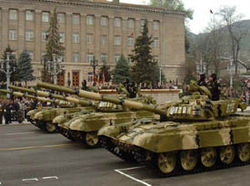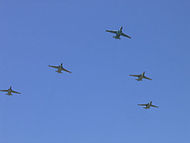- Armed Forces of Armenia
-
Armenian Armed Forces
Հայաստանի Զինված Ուժեր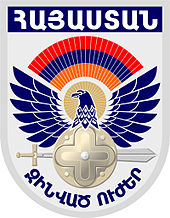
Emblem of the Armenian Armed ForcesService branches Armenian Army
Armenian Air Force
Armenian Air Defense
Armenian Border GuardHeadquarters Yerevan Leadership Commander-in-Chief President Serzh Sargsyan Minister of Defense Seyran Ohanyan Chief of staff Colonel-General Youri Khachatrov Manpower Military age 19 Conscription 24 months Available for
military service722,836 males, age 15–49,
795,084 females, age 15–49Fit for
military service551,938 males, age 15–49,
656,493 females, age 15–49Reaching military
age annually31,774 males,
31,182 femalesActive personnel 46,684 (Army 43,772, Air Force & AD 2,912). There are additional 4,748 paramilitary.[1] Reserve personnel 200,000 former service personnel with service in last 15 years[3] Deployed personnel  Kosovo - 70
Kosovo - 70
 Afghanistan - 40 [4]
Afghanistan - 40 [4]Expenditures Budget $ 386,000,000 (2011) [5] Percent of GDP 2.8% (2010)[6] Industry Foreign suppliers  Russia
Russia
 United States
United States
 Greece
Greece
 France [7]
France [7]
 Moldova [8]
Moldova [8]
 Ukraine[9]
Ukraine[9]Related articles History Military history of Armenia
The Armed Forces of the Republic of Armenia comprise two services: the Army, and the Air Force and Air Defense (a unified branch).[10] It was partially formed out of the former Soviet Army forces stationed in the Armenian SSR (mostly units of the 7th Guards Army of the Transcaucasian Military District). Being a landlocked country, Armenia has no navy.
The Commander-in-Chief of the military is the President of Armenia, currently Serzh Sargsyan. The Ministry of Defense is in charge of political leadership, currently headed by Seyran Ohanian, while military command remains in the hands of the General Staff, headed by the Chief of Staff, who is currently Lieutenant-General Yuri Khatchaturov.[11] Armenia established a Ministry of Defense on January 28, 1992. Border guards subject to the Ministry patrol Armenia's borders with Georgia and Azerbaijan, while Russian troops continue to monitor its borders with Iran and Turkey.[12] Since 2002, Armenia has been a member of the Collective Security Treaty Organization, which acts as another deterrent to Azeri military intervention over Nagorno-Karabakh.[13]
Contents
Treaty compliance
The Treaty on Conventional Armed Forces in Europe was ratified by the Armenian parliament in July 1992. The treaty establishes comprehensive limits on key categories of military equipment, such as tanks, artillery, armored combat vehicles, combat aircraft, and combat helicopters, and provides for the destruction of weaponry in excess of those limits. Armenian officials have consistently expressed determination to comply with its provisions and thus Armenia has provided data on armaments as required under the CFE Treaty. Despite this, Azerbaijan accuses Armenia of diverting a large part of its military forces to Nagorno-Karabakh and thus circumventing these international regulations. Armenia is not a significant exporter of conventional weapons, but it has provided support, including material, to the Armenians of Nagorno-Karabakh during the Nagorno-Karabakh War.
In March 1993, Armenia signed the multilateral Chemical Weapons Convention, which calls for the eventual elimination of chemical weapons. Armenia acceded to the nuclear Non-Proliferation Treaty as a non-nuclear weapons state in July 1993. The U.S. and other Western governments have discussed efforts to establish effective nuclear export control systems with Armenia and expressed satisfaction with Armenia's full cooperation.[citation needed]
General Staff
The Armenian Armed Forces are Headquartered in Yerevan, where most of the general staff is based. Currently headed by Chief of Staff General Seyran Ohanian, the General Staff is responsible for operational command of the Armenian Military and its three major branches.[14]
- Colonel-General Seyran Ohanyan - Defense Minister
- Colonel-General Yuri Khachaturov
- Colonel-General Mikael Harutyunyan - Chief Military Inspector and Presidential Advisor
- Colonel-General Gurgen Daribaltayan
- Colonel-General Harut Kassabian - Commader of Capital Guard
- Lieutenant-General Aghik Myurzabekyan
- Lieutenant-General Arthur Aghabekyan
- Lieutenant-General Gurgen Melkonyan
- Lieutenant-General Roland Kereshyan
In addition to the services listed above, Armenia established its own Internal Troops from the former Soviet Interior Troops after the dissolution of the Soviet Union. Up until December 2002, Armenia maintained a Ministry of Internal Affairs, but along with the Ministry of National Security, it was reorganised as a non-ministrial institution. The two organisations became the Police of the Republic of Armenia and the National Security Service.[15] In February 1999 the Deputy Minister of the Interior and Commander of the Internal Troops, Major General Artsrun Makarian, was found shot dead.
Army
According to IISS 2010, Armenia has 20 T-80 tanks[16], 100 T-72 tanks, 80 T-54 tanks and 80 BMP-1's, 20 BMP-1K, 30 BMP-2 and 22 BRM-1K. Wheeled APCs reported included 25 BTR-60s, 21 BTR-70s, 50 BTR-80s, 145 MT-LBs, and 120 BRDM-2 scout vehicles.
Although the Russians have supplied newer replacement equipment to Armenia over the years, the numbers have never been sufficient to upgrade all ground force formations and many of the lower readiness units still have older, Soviet-legacy systems that have not been upgraded or in many cases effectively maintained. These older systems are placing great demands on the logistics system for service, maintenance, replacement parts and necessary upgrades, costing the army dearly both financially and in overall readiness.The ground force is currently engaged in an effort of reassessment reorganisation and restructuring, as the future of Armenia's defence needs a revised force structure and unit mix. Clearly, the army must maintain much of its traditional mechanised formations, but it also is looking to lighten and make more mobile and self-sustainable a small number of other formations. It must develop these newer formations to support its international requirements and effectively operate in mountainous and other rugged terrain, but it must do this without affecting the mechanised capability that is needed to confront Azerbaijan's conventional forces.[17]
Since the fall of the Soviet Union, Armenia has followed a policy of developing its armed forces into a professional, well trained, and mobile military. In 2000, Centre for International Studies and Research reported that the Armenian Army has the most combat capability of the three Caucasian countries' armies (the other two being Georgia and Azerbaijan).[18] CSTO Secretary, Nikolay Bordyuzha, came to a similar conclusion after collective military drills in 2007 when he stated that, "the Armenian Army is the most efficient one in the post-Soviet space".[19] This was echoed more recently by Igor Korotchenko, a member of the Public Council, Russian Ministry of Defense, in a March 2011 interview with Voice of Russia radio.[20]
The Army is functionally divided into Active and Reserve Forces. Their main functions include deterrence, defense, peace support and crisis management, humanitarian and rescue missions, as well as social functions within Armenian society.
The Active Forces mainly have peacekeeping and defensive duties, and are further divided into Deployment Forces, Immediate Reaction, and Main Defense Forces. The Reserve Forces consists of Enhancement Forces, Territorial Defense Forces, and Training Grounds. They deal with planning and reservist preparation, armaments and equipment storage, training of formations for active forces rotation or increase in personnel.
During peacetime the Army maintains permanent combat and mobilization readiness. They become part of multinational military formations in compliance with international treaties Armenia is a signatory to, participate in the preparation of the population, the national economy and the maintenance of wartime reserves and the infrastructure of the country for defense.
In times of crisis the Army's main tasks relate to participation in operations countering terrorist activities and defense of strategic facilities (such as nuclear power plants and major industrial facilities), assisting the security forces in proliferation of weapons of mass destruction, illegal armaments traffic and international terrorism.
In case of low- and medium-intensity military conflict the Active Forces that are part of the Army participate in carrying out the initial tasks for the defense of the territorial integrity and sovereignty of the country. In case of a high intensity conflict the Land Forces, together with the Air Force, Air Defense and Border Guards, form the defense group of the Armenian Armed Forces aiming at countering aggression and protect the territorial integrity and sovereignty of the country.
Experiments in developing small arms have been undertaken in Armenia, producing the K-3 assault rifle, but Jane's Infantry Weapons estimates that the programme has ceased, and the rifle is not in widespread service with the army. The AK-74 is the standard issue rifle of the Armenian Army with older AKMs in reserve use.[21]
Air Force
 The Armenian Air Force consists of 15 Su-25 ground attack planes, 1 MiG-25 jet fighter, 12 Mil Mi-24 helicopter gunships, 6 L-39 trainer and attack aircraft, 16 Yak-52 trainer aircraft, 3 Il-76 cargo planes, 13 Mil Mi-8 transport helicopters, and 9 Mil Mi-2 light utiliy helicopters. There are additional 18 MiG-29 fighter jets of the Russian 102nd Military Base at Gyumri stationed.
The Armenian Air Force consists of 15 Su-25 ground attack planes, 1 MiG-25 jet fighter, 12 Mil Mi-24 helicopter gunships, 6 L-39 trainer and attack aircraft, 16 Yak-52 trainer aircraft, 3 Il-76 cargo planes, 13 Mil Mi-8 transport helicopters, and 9 Mil Mi-2 light utiliy helicopters. There are additional 18 MiG-29 fighter jets of the Russian 102nd Military Base at Gyumri stationed.Air Defense
The Armenian Air Defense is the anti-aircraft branch of the Armed Forces of Armenia. It was equipped and organized as part of the military reform program of Ter-Grigoriants. It consists of an anti-aircraft missile brigade and two regiments armed with 100 anti-aircraft complexes of various models and modifications, including the SA-8, Krug, S-75, S-125, SA-7, SA-10, SA-13, SA-16 and SA-18. Russia has SA-6 and S-300 long range surface-to-air missiles at the Russian 102nd Military Base. There are also 24 Scud ballistic missiles with eight launchers. Numerical strength is estimated at about 3,000 servicemen, with plans for further expansion.
In late December 2010, the Armenian Defense Minister, Seyran Ohanyan, officially acknowledged that the army are equipped with the Russian-made S-300 surface-to-air missiles. The statement was made while the Minister was inspecting a new air-defense command point that maintains “state-of-the-art equipment" built specifically for the operation of the S-300s. Russian specialists had begun training their Armenian counter-parts in 2005 in the use of the sophisticated missile systems. Speaking to Radio Free Europe's Armenian service, Defense Ministry spokesman David Karapetyan confirmed that the Armenian army now has S-300s in its missile arsenal. He declined to specify their number and dates of delivery.[22]
Surface to Surface Missiles
- BM-21 40+ vehicles
- WM-80 4 vehicles bought from China in 1994.
- ScudB 6 TEL and 36 ballistic missiles, left from the Soviet Union after 1992.
- BM-30 Smerch 300mm MLRS, Armenia showed intrest in these systems in 2011 Belarus military exhibition.
Military of Karabakh
Main article: Nagorno-Karabakh Defense ArmyIn addition to forces mentioned above, there are 20,000 active soldiers defending Nagorno-Karabakh, a disputed territory which seceded from Azerbaijan in 1991 and is now a de-facto independent state. They are well trained and well equipped with the latest in military software and hardware.[23] Karabakh army's heavy military hardware includes: 316 tanks, 324 armored vehicles, 322 artillery pieces of calibers over 122 mm, 44 multiple rocket launchers, and a new anti-aircraft defense system.[24] In addition, the NKR Defence Army maintains a small air-force of 2 Su-25s, 5 Mi-24s and 5 other helicopters.
International military cooperation
Russia
Russia is Armenia's closest ally. The Russian 102nd Military Base, the former 127th Motor Rifle Division, is stationed in Gyumri. The military alliance of the two nations and, in particular, the presence of Russian troops on Armenian soil has been a key element of Armenia's national security doctrine since Armenia gained independence in 1991.[25] Russia stations an estimated 5,000 soldiers of all types in Armenia, including 3,000 officially reported to be based at the 102nd Military Base. In 1997, the two countries signed a far-reaching friendship treaty, which calls for mutual assistance in the event of a military threat to either party and allows Russian border guards to patrol Armenia's frontiers with Turkey and Iran. In early 2005, the 102nd Military Base had 74 tanks, 17 battle infantry vehicles, 148 armored personnel carriers, 84 artillery pieces, 18 MiG-29 fighters, one battery of SA-6 and two batteries of S-300 anti-aircraft missiles. However in 2005-2007, following an agreement on the withdrawal of two Russian military bases from Georgia, a great deal of military hardware was moved to the 102nd Base from the Russian 12th Military Base in Batumi and the 62nd Military Base at Akhalkalaki, Georgia. Russia also supplies weapons at the relatively lower prices of the Russian domestic market as part of a collective security agreement since January 2004.[26]
According to unconfirmed reports by the Azeri media, Russia has supplied $1 billion worth of arms and ammunitions to Armenia in 1996; and handed over an additional $800 million worth of arms to Armenia in 2008-2009. According to AzerNews, the weapons in this latest transfer include 21 tanks, 12 armored vehicles, five other battle machines, a great number of rocket launchers, over 1,050 cases of grenades, nearly 7,900 types of ammunition, 120 grenade launchers, over 4,000 sub-machine guns, TNT fuses, mines of various types, 14 mine-launchers, 9 Grad launchers, five canons, and other weapons.[27]
Officer training is another sphere of Russian-Armenian military cooperation. In the first years of sovereignty when Armenia lacked a military educational establishment of its own, officers of its army were trained in Russia. Even now when Armenia has a military college on its own territory, the Armenian officer corps honors the tradition and is trained at Russian military educational establishments. Currently, 600 Armenian servicemen are being trained in Russia. In Armenia as of 1997, the training was conducted by the "In the name of Marshal Bagramyan" Training Brigade.[28]
At the first meeting of the joint Russian-Armenian government panel for military-technical cooperation that took place during autumn 2005, Prime Minister Mikhail Fradkov reported that, Russian factories will participate in the Armenian program of military modernization, and that Russia is prepared to supply the necessary spare parts and equipment. In accordance with this agreement, Armenia and Russia agreed to work together in exporting weapons and other military equipment to third countries in December 2009. The export agreement was signed by Defense Minister Seyran Ohanian and a visiting senior Russian official, Konstantin Biryulin, during a meeting of a Russian-Armenian inter-governmental commission on bilateral military-technical cooperation. The agreement envisages the two countries' interaction in exporting military production to third countries, which will help to strengthen the armed forces of the two states, and further cement the already close Russian-Armenian military cooperation.[25]
A Russian-Armenian defense agreement signed in August 2010 extends Russia’s military presence in Armenia till 2044 and commits Russia to supplying Armenia with modern and compatible weaponry and special military hardware at reduced prices.[29]
At the beginning of 2009, Azerbaijani media published allegations that Russia had made extensive weapons transfers to Armenia throughout 2008 costing about $800 million. On January 12, 2009, the Russian ambassador was invited to the Azerbaijani Ministry of Foreign Affairs and asked about this information. On January 21, 2009, Russian ministry of foreign relations officially denied the transfers.[30] According to the materials published by WikiLeaks in December 2010, Azerbaijani defence minister Safar Abiyev claimed that in January 2009 during his visit to Moscow, his Russian counterpart Anatoly Serdyukov unofficially had admitted to weapons transfers "after the second bottle of vodka" that evening, although officially it was denied.[31]
Collective Security Treaty Organisation
On October 7, 2002, the Presidents of Armenia, Belarus, Kazakhstan, Kyrgyzstan, Russia and Tajikistan, signed a charter in Tashkent, founding the Collective Security Treaty Organisation (CSTO) (Russian: Организация Договора о Коллективной Безопасности (ОДКБ~ODKB)) or simply Ташкентский договор (The Tashkent Treaty). Nikolai Bordyuzha was appointed secretary general of the new organisation. On 23 June 2006, Uzbekistan became a full participant in the CSTO and its membership was formally ratified by its parliament on 28 March 2008.[32] Furthermore, the CSTO is an observer organisation at the United Nations General Assembly.
The charter reaffirmed the desire of all participating states to abstain from the use or threat of force. Signatories would not be able to join other military alliances or other groups of states, while aggression against one signatory would be perceived as an aggression against all. To this end, the CSTO holds yearly military command exercises for the CSTO nations to have an opportunity to improve inter-organisation cooperation. The largest-scale CSTO military exercise held, to date, were the "Rubezh 2008" exercises hosted in Armenia where a combined total of 4,000 troops from all 7 constituent CSTO member countries conducted operative, strategic, and tactical training with an emphasis towards furthering the efficiency of the collective security element of the CSTO partnership.[33]
The Ministry of Defense of Armenia has repeatedly stated that it would expect direct military assistance from the CSTO in case war with Azerbaijan resumes, as recently as December 2009, Defense Minister Ohanyan made the same statement. According to the Armenian website Asbarez, in August, 2009, Nikolay Bordyuzha, the CSTO's secretary-general, confirmed that official Yerevan can count on such support.[25]
On February 4, 2009, an agreement to create the Collective Rapid Reaction Force (KSOR) was reached by five of the seven CSTO members, with plans finalized on June 14, 2009. Armenia is one of the five member states. The force is intended to be used to repulse military aggression, conduct anti-terrorist operations, fight transnational crime and drug trafficking, and neutralize the effects of natural disasters.[34][35]
NATO
Armenia participates in NATO's Partnership for Peace (PiP) program and it is in a NATO organization called Euro-Atlantic Partnership Council (EAPC). Armenia is in the process of implementation of Individual Partnership Action Plans (IPAPs), which is a program for those countries that have the political will and ability to deepen their relationship with NATO. Cooperative Best Effort exercise (the first where Russia was represented) was run on Armenian territory in 2003.
Greece
Greece is Armenia's closest ally in NATO and the two cooperate on multiple issues. A number of Armenian officers are trained in Greece every year, and military aid/material assistance has been provided to Armenia. In 2003, the two countries signed a military cooperation accord, under which Greece will increase the number of Armenian servicemen trained at the military and military-medical academies in Athens.
In February 2003, Armenia sent 34 peace keepers to Kosovo where they became part of the Greek contingent. Officials in Yerevan have said the Armenian military plans to substantially increase the size of its peace-keeping detachment and counts on Greek assistance to the effort. In June 2008, Armenia sent 72 peacekeepers to Kosovo for a total of 106 peacekeepers.
Baltic States
Lithuania has been sharing experience and providing consultations to the Armenian Defense Ministry in the field of democratic control of armed forces, military and defense concepts and public relations since 2002. Started in 2004, Armenian officers have been invited to study at the Lithuanian War Academy and the Baltic Defense College in Tartu, Estonia. Lithuania covers all study expenditures. In early 2007, two Armenian officers for the first time took part in a Baltic lead international exercise, Amber Hope, which was held in Lithuania.[36]
United States
The United States has been steadily upping its military clout in the region. In early 2003, United States Department of Defense announced several major military programs in the Caucasus. Washington's military aid to Armenia in 2005 amounted to $5 million, and in April 2004, the two sides signed a military-technical cooperation accord.[citation needed] In late 2004, Armenia deployed a unit of 46 soldiers, which included bomb-disposal experts, doctors, and transport specialists, to Iraq as part of the American-led Multi-National Force Iraq. In 2005, the United States allocated $7 million to modernize the military communications of the Armenian Armed Forces.
Peacekeeping operations
Currently Armenia is involved in peacekeeping operations in Kosovo and Afghanistan. There are also debates within the government to send peacekeepers to Lebanon since there are a large number of Armenians living there.
Kosovo
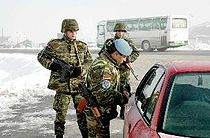 An Armenian patrol maintaining a checkpoint in Kosovo.
An Armenian patrol maintaining a checkpoint in Kosovo.
There are currently 70 Armenian soldiers serving in Kosovo as peacekeepers.
Armenia joined the Kosovo Force in Kosovo in 2004. Armenian "blue helmets" serve within the Greek Army battalion. The relevant memorandum was signed on September 3, 2003 in Yerevan and ratified by the Armenian Parliament on December 13, 2003. The sixth deployment of Armenian peacekeepers departed for Kosovo on November 14, 2006.[37] In 2008, the Armenian National Assembly voted unanimously to double the peacekeeping force in Kosovo by sending an extra 34 peacekeepers to the region, increasing the total number of peacekeepers in the region to 68.[38] Artur Aghabekian, chairman of the Armenian parliament's committee on defense and security, cited the need to double the forces to help Kosovo achieve full international recognition adding that that would set an important precedent for the full recognition of the Nagorno-Karabakh Republic.[39]
Iraq
After the end of the invasion of Iraq, Armenia deployed a unit of 46 peacekeepers under Polish command. Armenian peacekeepers were based in Al-Kut, 62 miles from the capital of Baghdad.[40] On July 23, 2006 the fourth shift of Armenian peacekeepers departed for Iraq. The shift included 3 staff commanders, 2 medical officers, 10 combat engineers and 31 drivers. Throughout the length of the deployment, there was one Armenian wounded and no deaths. The Armenian government extended the small troop presence in Iraq by one year at the end of 2005 and 2006.[41][42] On October 7, 2008, Armenia withdrew its contingent of 46 peacekeepers. This coincided with the withdrawal of the Polish contingent in Iraq.[43]
Afghanistan
Currently, Armenia deployed 40 soldiers to Afghanistan as part of the NATO-led International Security Assistance Force (ISAF). They are serving under German command protecting an airport in Konduz.[4]
Non-combat deaths
The Armenian government’s stated efforts to strengthen and reform the military are called into question by continuing non-combat deaths and other violent incidents in the army ranks, which have come under greater public scrutiny in 2010. It is very likely that these incidents have some connection with the former Soviet Ground Forces' phenomenon of dedovshchina (institutionalised bullying). In a report released in February 2011, the Helsinki Citizens’ Assembly, a Vanadzor-based human rights group, claimed that 42 Armenian soldiers died in 2010, and that only 9 of them were shot by Azerbaijani forces. It said more than half of them were murdered by fellow servicemen.[44]
References
- ^ The Military Balance 2010. London: Routledge for the IISS. 2010. p. 174. ISBN 1857435575.
- ^ Blandy, C. W. "Azerbaijan: Is War Over Nagornyy Karabakh a Realistic Option?" Advanced Research and Assessment Group. Defence Academy of the United Kingdom, Caucasus Series 08/17, 2008, p.16.
- ^ IISS (2007). The Military Balance 2007. London: Routledge for the IISS. p. 155. ISBN 978-1-85743-437-8.
- ^ a b http://www.rferl.org/content/Armenian_Parliament_Endorses_Troop_Deployment_To_Afghanistan/1898715.html
- ^ http://www.rferl.org/content/Armenia_Unfazed_By_Azerbaijans_Growing_Military_Spending/2201464.html
- ^ https://www.cia.gov/library/publications/the-world-factbook/geos/am.html
- ^ http://www.mil.am/eng/?page=2&p=0&id=1185&y=2010&m=02&d=12
- ^ http://www.rferl.org/content/azerbaijan_armenia_moldova_arms_shipment/24361791.html
- ^ http://www.eurasianet.org/node/64014
- ^ CIA World Factbook 2010, Armenia
- ^ http://www.mil.am/eng/index.php?page=7
- ^ http://www.globalsecurity.org/military/world/russia/102-military-base.htm
- ^ http://www.globalsecurity.org/military/world/int/csto.htm
- ^ http://www.mil.am/eng/index.php?page=6
- ^ Taylor and Francis, Europa World Yearbook 2004, p.554
- ^ Jane's World Armies Armenia, 2008.
- ^ Armenia (Armenia), Assessment Janes World armies
- ^ Robert Fairbanks, Public and private armies in the Caucasus, Sciences Po, November 2000
- ^ http://www.panarmenian.net/eng/world/news/21078/
- ^ http://news.am/eng/news/49916.html
- ^ http://www.janes.com/articles/Janes-Infantry-Weapons/K-3-5-45 mm-assault-rifle-Armenia.html
- ^ http://asbarez.com/90524/armenia-confirms-possession-of-sophisticated-missiles/
- ^ C. W. Blandy, Azerbaijan: Is War Over Nagornyy Karabakh a Realistic Option?, Advanced Research and Assessment Group, Defence Academy of the United Kingdom, Caucasus Series 08/17, 2008, p.16
- ^ DeRouen, Karl and Uk Heo (eds.) Civil Wars of the World: Major Conflicts since World War II. Santa Barbara, California: ABC-CLIO, 2007, p. 151.
- ^ a b c http://www.asbarez.com/2009/12/17/armenia-russia-sign-arms-export-deal-2/
- ^ "Russian supply". http://newsfromrussia.com/main/2003/11/12/51161.html. Retrieved 2006-03-12.
- ^ AzerNews Russia `donates` $800m arms to Armenia 14-01-2009
- ^ Ministry Of Defence of The Republic Of Armenia, Official Web Site
- ^ http://www.armenialiberty.org/content/article/2200677.html
- ^ Day.az. МИД России опроверг информацию о поставках Армении российского оружия на $800 млн.
- ^ The Guardian. Embassy cables: Truth about Putin and Medvedev – over a bottle of vodka
- ^ http://www.eurasianhome.org
- ^ http://www.pims.org/news/2008/08/06/rubezh-2008-the-first-large-scale-csto-military-exercise
- ^ http://en.rian.ru/russia/20090204/119984654.html
- ^ With Russian Prodding, CSTO Begins Taking Shape
- ^ Lithuanian Defense Minister Going To Armenia
- ^ "Armenia to deploy more soldiers to Kosovo". http://www.serbianna.com/news/2006/02761.shtml. Retrieved 2006-03-12.
- ^ Armenia to double its peacekeepers' contingent in Kosovo
- ^ Armenia To Send More Troops To Kosovo
- ^ "Armenia's third contingent of peacekeepers now in Iraq". http://news.monstersandcritics.com/intelandterror/article_1089436.php/Armenias_third_contingent_of_peacekeepers_now_in_Iraq. Retrieved 2006-03-12.
- ^ "Armenian defense minister to visit Iraq as Armenia to extend the small troop presence". The Associated Press. 2006-11-13. http://library.aua.am/library/news/archive/2006_11-14.htm. Retrieved 2007-02-20.
- ^ "ARMENIAN PEACEKEEPERS TO STAY AN EXTRA YEAR IN IRAQ". AZG Armenian Daily. 06/12/2005. http://www.azg.am/?lang=EN&num=2005120601. Retrieved 2007-02-20.
- ^ Armenian troops pull out of Iraq: US military
- ^ "Armenia Reports ‘Unprecedented’ Arms Acquisitions". RFE/RL. 2011-02-22. http://www.azatutyun.am/content/article/2317594.html. Retrieved 2011-02-22.
 This article incorporates public domain material from websites or documents of the CIA World Factbook.
This article incorporates public domain material from websites or documents of the CIA World Factbook. This article incorporates public domain material from websites or documents of the United States Department of State (Background Notes).
This article incorporates public domain material from websites or documents of the United States Department of State (Background Notes).
External links
- Armenian Ministry of Defense
- Vladimir Petrov, How South Caucasus was armed, Centre for Analysis of Strategies and Technologies (Moscow, Russia)
- "Armenian National Security"
- Armenian Military Photo Gallery
- "Fit for a Fight?: Armenia and Azerbaijan flex military muscles, vow to not be overcome"
- Armenia, Greece Discuss Closer Military Ties
- Armed Forces of Caucasian countries
Categories:- Military of Armenia
- Conscript militaries
Wikimedia Foundation. 2010.

